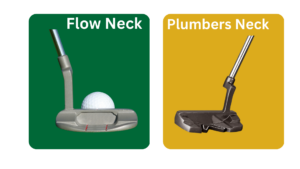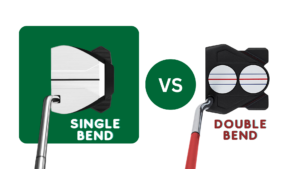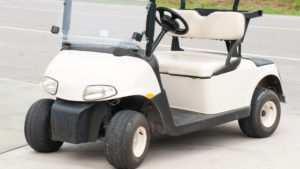Golfers of all levels are always looking for the perfect putter shaft to help them achieve better results on the course. Selecting the ideal putter shaft from all the available options can be a difficult task. The choice between single bend and double bend putter shafts may seem like a small detail, but it can make a big difference in your game.
In this blog post, we’ll compare single vs double bend putter shafts and discuss how to choose the best option for your style of play. We’ll also provide some tips on maintaining your new club so that you get maximum performance from every stroke.

Table of Contents:
- Single Bend Putter Shafts
- Benefits:
- Drawbacks:
- Double Bend Putter Shafts
- Comparison of Single and Double Bend Putter Shafts
- Design:
- Alignment:
- Balance:
- Choosing the Right Putter Shaft for You
- Proper balance
- Consider the weight
- Check the grip
- Maintenance Tips for Your Putter Shafts
- Cleaning and storage
- Color prevention
- FAQs in Relation to Single Bend vs Double Bend Putter Shaft
- Conclusion
Single Bend Putter Shafts
Single bend putter shafts are a popular choice among golfers of all skill levels. Single bend putters offer a steady and precise feel, making them suitable for golfers regardless of ability.
Single bend putter shafts feature one bend in the center that allows the clubhead to stay in contact with the ball longer at impact, resulting in more consistent shots. The single-bend design also reduces vibration and provides greater accuracy when putting on uneven surfaces or off-center hits.

Benefits:
The main benefit of a single bend putter shaft is its improved accuracy and consistency compared to traditional flat sticks. This makes them great for those who want to improve their short game or just need a little extra help with distance control.
Additionally, these clubs can be adjusted easily depending on your stance width or stroke style without having to buy a new club every time you make changes. This type of center-shafted putter is much easier to control.
Finally, they tend to have lighter heads than double bent models which helps increase swing speed for more power behind each shot.
Drawbacks
While there are many benefits associated with single bend putters, they do come with some drawbacks as well. For example, because of the single-bend design, they can be difficult to align properly at the address due to its curved shape which can cause misalignment issues if not set up correctly from the start of your round.
Furthermore, these clubs may lack forgiveness when hitting off-center shots since there’s less room for error due to its smaller sweet spot size compared to other types of clubs like hybrids or drivers which have larger sweet spots for added forgiveness on mishits.
A single-bend putter shaft offers a classic design that is well-suited for golfers of all skill levels. Double bend putter shafts, on the other hand, provide an enhanced level of control and accuracy to help improve your game.
Double Bend Putter Shafts
Double bend putter shafts are becoming increasingly popular in the golfing world. This type of shaft features two bends that allow for more control and accuracy when putting. The double bend helps to ensure a square clubface at impact, resulting in improved consistency on the green.

Benefits:
The primary benefit of using a double bend putter shaft is increased accuracy and precision while putting. With this design, golfers can achieve a consistent swing path with less effort and fewer adjustments needed mid-swing.
These clubs often come with an adjustable lie angle feature which allows players to customize their setup for optimal performance. Double bend putters are usually lighter than traditional single bent models, making them easier to use during long rounds or practice sessions. Sometimes, a straight shaft can be replaced by a double bend shaft.
Drawbacks:
One potential downside of using a double bend putter is that it may take some time for players to adjust to the feel of the new clubhead shape as compared to single bent models.
Additionally, these clubs can be slightly more expensive than standard single bent options due to their unique design features and materials used in construction.
Double bend putter shafts provide a more consistent and accurate putting stroke, but they can be expensive. Let’s evaluate the performance and cost of single- vs double-bend putter shafts, taking into account their potential expense.
Comparison of Single and Double Bend Putter Shafts
Single and double bend putter shafts refer to the shape of the shaft that connects the putter head to the grip. A single bend shaft has one angle bend where the shaft meets the head, while a double bend shaft has two angles bends, one near the head and another near the grip.
The main difference between the two is the way they affect the balance and alignment of the putter. Here are some key factors to consider:
Design:
Single bend putter shafts have a single bend that connects the shaft to the putter head, creating a straight line from the shaft to the face of the putter. On the other hand, double bend putter shafts have two bends, one at the hosel and one at the shaft, which creates an angled offset between the shaft and the putter head.
Alignment:
Single bend shafts tend to provide a more straight back and through putting stroke. The angle of the shaft makes it easier to align the putter face with the target. On the other hand, double bend shafts may require more attention to ensure proper alignment as the angles can create a more arcing putting stroke.
Balance:
Double bend shafts have a higher center of gravity, which can make the putter head feel heavier and more stable during the stroke. This can help with consistency and accuracy. Single bend shafts have a lower center of gravity and can promote a smoother, more even stroke.
Single and double bend putter shafts offer different performance benefits for golfers of all levels. Therefore, it is important to consider the differences between them before choosing a new putter shaft that fits your swing style and putting stroke.
Choosing the Right Putter Shaft for You
When selecting a putter shaft, both new and seasoned golfers should consider various elements.

Proper balance
Shorter shafts can provide greater accuracy, yet lack the power of longer ones when it comes to putting from a distance. A shorter shaft will offer greater accuracy but may not provide as much power when putting from long distances. It’s important to find a balance between these two qualities that work for you and your swing style.
Consider the weight
The next factor to consider is weight. Putters with heavier heads tend to offer more stability during shots, while lighter heads give players increased speed and feel around the green. Heavier clubs are generally better suited for slower swings, while lighter clubs work best with faster ones; so depending on how fast or slow you swing, you’ll want to choose accordingly.
Check the grip
Finally, there are different types of grips available for putters which can have an effect on performance too: softer grips allow for more feedback from each shot whereas firmer grips help maintain consistency in each stroke; again this will depend on what type of golfer you are and what kind of experience you prefer when playing with your putter.
Ultimately, finding the right fit for your swing style and putting stroke requires some trial-and-error before settling on one particular club that works best for you. By taking into account all three factors mentioned above (length, weight & grip), chances are high that any golfer should be able to find their perfect match soon enough.
When choosing the right putter shaft for you, it is important to consider your playing style and putting stroke. To maintain the best performance of your putters, regular upkeep is necessary.
Maintenance Tips for Your Putter Shafts

Cleaning and storage
These are key to keeping your putter shafts in good condition. Maintaining the quality of your putters over time requires appropriate cleaning and storage practices.
To clean, use a soft cloth or brush with warm water and mild soap. Avoid harsh chemicals as these can damage the finish of the club head or shaft. After cleaning, make sure to dry completely before storing away.
Color prevention
To prevent discoloration, keep your putters away from direct sunlight when not in use. If not being employed frequently, store them in a chill, arid area such as a wardrobe or locker that is devoid of humidity and wetness which could bring about corrosion on metallic elements like the poles. Make sure there’s enough space between each club so they don’t rub against each other while stored away.
Lastly, always be aware that regular checkups every few months is an essential part of maintaining your clubs’ optimal performance levels over time; so take some “me” time now and then to give yourself peace of mind by ensuring all parts are still working properly together.
FAQs in Relation to Single Bend vs Double Bend Putter Shaft
Why use a double bend putter shaft?
A double bend putter shaft is an excellent choice for golfers of all skill levels. The unique design of the shaft helps to promote a more consistent stroke and better accuracy when putting. It also provides greater stability, allowing you to make smoother swings with less effort.
Furthermore, it allows for increased control over your shots due to its reduced torque at impact which reduces twisting on off-center hits. In summary, using a double bend putter shaft can provide improved performance and greater confidence in your game.
Who should use a double bend putter shaft?
This type of shaft offers an increased amount of stability and control, which can help experienced players maintain a consistent ball roll and distance. It also helps to keep the clubface square at impact with the ball, resulting in more accurate shots.
However, this type of putter requires practice to get used to its unique feel so it may not be ideal for beginner or intermediate players looking for maximum forgiveness on off-center hits.
Are single bend putters face balanced?
Yes, It is a face-balanced putter. This means that the center of gravity is located directly in line with the shaft and putting stroke plane.
Face balancing helps to ensure a consistent roll on every putt and allows for more accuracy when aiming at your target. It also provides stability during off-center hits, which can help improve consistency over time.
Conclusion
Choosing the right putter shaft for your game can be a daunting task. With so many options available, it’s important to understand the differences between single and double bend putter shafts before making a decision.
Single bend putters offer more stability while double bends provide increased feel and accuracy when striking the ball. Knowing your playing style can help you decide which putter shaft is the most suitable for your golf game. Whether it’s a single or double bend putter shaft that works best for you, keeping up with regular maintenance on both types of clubs is essential in order to maximize performance out on the course.
Discover the best putter shaft for your game by reading our detailed reviews and expert advice on single bend vs double bend putters. Take your putting to a whole new level with GolfingEagle.com!






